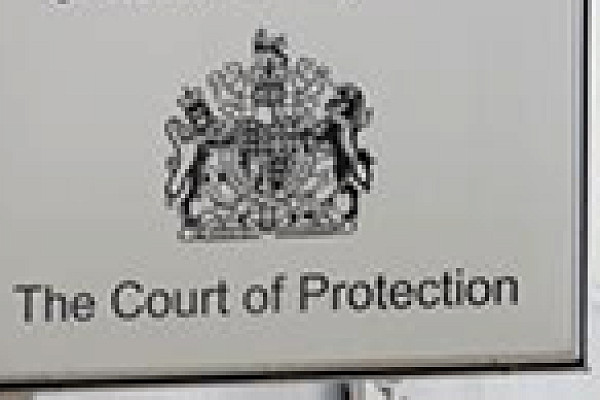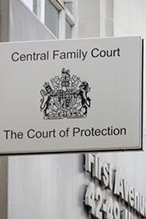

The final say
News
Must read
Families refusing access to support
Features Test

Producing robust capacity assessments and the approaches to assessing capacity

Disability discrimination and proportionality in housing management

Cross-border deprivation of liberty

Dealing with unexplained deaths and inquests

Court of Protection case update: May 2025
Features

Producing robust capacity assessments and the approaches to assessing capacity

Disability discrimination and proportionality in housing management

Cross-border deprivation of liberty

Dealing with unexplained deaths and inquests

Court of Protection case update: May 2025
Sponsored articles
What is the role of the National Trading Standards Estate & Letting Agency Team in assisting enforcement authorities?
Webinars
Is Omeprazole the new EDS?
More features
Provision of same-sex intimate care
Court of Protection case update: April 2025
High Court guidance on Article 3 engagement in care at home cases
‘Stitch’, capacity and complexity
Issuing proceedings in best interests cases
Court of Protection case law update: March 2025
The Health and Social Care (Wales) Bill Series – Regulation and Inspection of Social Care
The Health and Social Care (Wales) Bill Series – Direct Payments for NHS Continuing Healthcare
What is the right approach to Care Act assessments?
Disabled people in immigration bail: the duties of the Home Office and local authorities
Capacity, insight and professional cultures
Court of Protection update: February 2025
Setting care home fees
Could this be the end for local authority-provided residential care?
“On a DoLS”
It’s all about the care plan
Court of Protection case update: January 2025
Mental capacity and expert evidence
Best interests, wishes and feelings
Capacity, sexual relations and public protection – another go-round before the Court of Appeal
Court of Protection Update - December 2024
Fluctuating capacity, the “longitudinal approach” and practical dilemmas
Capacity and civil proceedings
Recovering adult social care charges via insolvency administration orders
Court of Protection case update: October 2024
Communication with protected parties in legal proceedings
The way forward for CQC – something old, something new….
The Ombudsman, DoLS and triaging – asking the impossible?
Outsourcing and the Human Rights Act 1998 – the consequences
Commissioning care and support in Wales: new code of practice
Senior judge at Court of Protection admits setbacks since Mental Capacity Act introduced
- Details
The Court of Protection has had to endure “more than its fair share of setbacks” since 1 October 2007, when the Mental Capacity Act 2005 came into force, its senior judge has admitted.
Writing in the foreword to the court’s first report, which covered a 27-month period to 31 December 2009, Denzil Lush said that he “could not pretend that it has been plain sailing”.
The senior judge pinned the blame on the failure to anticipate – prior to implementation of the Act – the volume of work that would inundate the court during the initial transition period, and the overall burden it would place on the judges and staff.
The court has, until recently, had insufficient judges to handle its workload, Lush claimed. It was allotted four full-time judges, one of whom suffered from long-term sickness, when the amount of work would have merited appointing six.
However, the senior judge expressed the hope that the appointment of three new district judges, who took up their posts in April 2010, would relieve the pressures.
Lush agreed that complaints from service users that the court’s procedures had become more bureaucratic and time-consuming were justified. “It is anticipated that the review of the court’s rules, forms and practice directions, which was announced by the President of the Family Division in December 2009, will result in improvements in each of these respects,” he suggested.
The senior judge added that one of the main aims of the 2005 Act – to create a unified jurisdiction, combining that of the old Court of Protection in relation to property and financial affairs with the personal welfare jurisdiction exercised by the High Court judges of the Family Division – had yet to be fully realised.
“There remain significant differences of practice between property and affairs cases and welfare cases,” he said.
Lush highlighted, on a positive note, the fact that the Association of Public Authority Deputies had commented that the court’s orders “are fit for purpose and are making a significant contribution to the safeguarding of vulnerable adults”.
The court’s regional protocol for attended hearings was also working satisfactorily.
Inquiry into Mid-Staffs hospital to put spotlight on organisations with monitoring role
- Details
A full public inquiry into failings at Mid-Staffordshire NHS Foundation Trust – announced by the Health Secretary, Andrew Lansley, yesterday – is to examine the role of commissioning, supervisory and regulatory bodies in monitoring of the trust.
The Department of Health said the inquiry would “seek to expose how events at the trust went undetected and unchallenged for so long” by these organisations.
The inquiry will be chaired by Robert Francis QC, who also handled the first independent inquiry into the Stafford Hospital’s problems, and have the power to compel witnesses to attend and speak under oath.
The bodies to be scrutinised by the inquiry include:
- The Department of Health
- The local strategic health authority
- The local Primary Care Trust(s)
- The Independent Regulator of NHS Foundation Trusts (Monitor)
- The Care Quality Commission
- The Health and Safety Executive
- Local scrutiny and engagement bodies, and
- The local Coroner.
The terms of reference call for the inquiry to identify the lessons to be drawn from such an examination as to how in the future the NHS and the bodies that regulate it can ensure that failing and potentially failing hospitals or their services are identified as soon as practicable.
Francis will be allowed to appoint an expert panel with expertise in regulatory systems and NHS management to support the inquiry’s work.
In March this year the Local Government Association called for primary care trusts and hospitals to be made accountable to local authorities in the wake of Francis’ first report, which revealed a catalogue of failures at Stafford Hospital between 2005 and March 2009.
Regulators had previously decided that more than 400 people had died at the hospital than would have been expected.
The Health Secretary has asked for a report to be delivered by March 2011.
Lansley said: “We know only too well what happened at this hospital – what we need to know is how and why. A full public inquiry will shed light on uninvestigated areas and help us to understand and learn from them.”
The minister also announced measures to strengthen protection for NHS staff who whistle blow. These include reinforcing rights and responsibilities for staff and employers in the NHS Constitution, issuing new guidance to the NHS stating that contracts of employment should cover whistle blowing, and supporting staff who raise concerns.
Lewisham hails joint commissioning deal with local NHS as "significant milestone"
- Details
Lewisham Council has reached an agreement with NHS Lewisham that will see the two organisations jointly commission adult health and social care services in the borough.
The two parties described the agreement as a “significant milestone” in the ongoing development of their partnership.
In a statement, they said the new joint commissioning arrangements would “improve the ability of both partners to design services around the needs of services users, rather than from the perspective of meeting the council’s and NHS Lewisham’s statutory obligations in respect of social care and health”.
The agreement will see the creation of an overall fund for health and social care needs, improving the ability of the parties’ ability to manage budgets more effectively.
Sir Steve Bullock, the Mayor of Lewisham, said the arrangements would provide much greater flexibility in providing for people’s needs. “Not only does it promise to deliver better services, but increased value for money,” he added.
The chief executive of NHS Lewisham, Gil Galliano, said: “The new agreement builds on our existing practice to work closely with key local organisations. It is altogether a far more efficient, effective and fair way to deliver vital services to some of the most vulnerable people in our community.
“It will allow us to develop more robust and flexible joint commissioning structures and mean we are better placed to respond to the personalisation agenda or any future policy changes.”
In the best interest - part three
- Details
In the third and final article of a three-part series on best interests decisions on personal welfare applications in the Court of Protection and the High Court over the last twelve months, Victoria Butler-Cole and Alex Ruck Keene look at bringing proceedings.
Proceedings are often instigated by local authorities, whether due to concern about an individual’s wellbeing, or because of disputes with family members which have not been able to be resolved in any other way. There are a number of common pitfalls for local authorities to be aware of and to avoid, in order to obtain the swiftest possible progress of a case through the Court of Protection.
Pre-proceedings
Before proceedings are even contemplated, it is important that local authorities have a realistic view of the time and resources that will need to be invested. Proceedings in the Court of Protection are usually lengthy and expensive. Expert reports may be commissioned, many hearings may be required at which social workers will often be needed, and it is difficult to stop proceedings once they have been started. If there is any prospect of a dispute being settled through mediation or discussion, this should be explored thoroughly.
Further, thought must be given as to whether proceedings are required in any event.
For example, where the local authority has granted a standard authorisation for a deprivation of liberty, the mere fact that a family member may disagree with that authorisation does not necessarily mean that the local authority has to take the matter to court. This, again, might well be something that could be addressed by way of other measures, for instance by reviewing the best interests assessment in light of the family member’s comments.
At present, however, there is something of a void in terms of guidance (either from cases or by way of Practice Directions) as to when the local authority should take matters to Court. This may be contrasted with the position that prevailed prior to the coming into force of the MCA 2005, when the Practice Note (Official Solicitor: Declaratory Proceedings: Medical and Welfare Decisions for Adults who Lack Capacity) – adopting as valuable guidance to be followed the approach suggested by the Official Solicitor – indicated that “[t] The claimant should usually be the NHS trust or other body responsible for the patient's care, such as a local authority. Should they decline to bring proceedings, any properly interested person, such as a family member or other individual closely connected with the patient, may bring proceedings, in which case the body with clinical or caring responsibility should be made a party Re S (Hospital Patient: Court's Jurisdiction) [1996] Fam 1, [1995] 1 FLR 1075”.
It is certainly the case that, if a family member does bring proceedings and the local authority is – inevitably – brought in as a party, it will generally be the case that the Court will look to the local authority to act as the applicant, at least in terms of the preparation of bundles and so forth. This is particularly so when the family member is unrepresented, but we have had experience of the Court directing that the local authority be made the applicant even where it has expressed deep unwillingness to do so. Quite whether this is something the Court actually has jurisdiction to do is another question, but as a matter of pragmatism, it makes a great deal of sense for the local authority to act as applicant unless there are very good reasons not to do so: in our experience, cases where this is not the case tend to take even longer and consume even more resources.
If proceedings are required on what appears to be a limited basis, for example in relation to DOLS, or contact only, it is important to ensure that all underlying matters, for example residence and care, have been thoroughly investigated and appropriate best interests decisions made and agreed. Otherwise, it will be very easy for the original point on which proceedings are brought to be expanded to incorporate other elements of the individual’s care and to take up considerable time and resources as a result.
Having established that proceedings are required, it is vital that good quality evidence as to mental capacity is obtained:
- this means that evidence should ideally be obtained from a psychiatrist, and should address expressly the test for capacity under the Mental Capacity Act 2005. Reports from general practitioners can be inadequate due to their relative lack of familiarity with questions of capacity (and we have heard that general practitioners are in any event increasingly unwilling to provide them without charging a fee).
- local authorities may wish to identify psychiatrists working in their area who could be asked to produce capacity reports and who could be given particular training about the law. They should, at a minimum, have read (or at least have access to) the BMA/Law Society book Assessment of Mental Capacity, A Practical Guide for Doctors and Lawyers, in its 3rd edition (published December 2009), and not merely because authors of this paper contributed to it;
- In cases where there is guidance from case-law about how to apply the test of capacity, for example in relation to capacity to consent to sexual relations, and capacity to consent to marriage, it is prudent to ensure that the person assessing capacity is familiar with this guidance and prepares a report that demonstrates an understanding of the proper legal approach;
- in all cases, evidence should be obtained not merely in relation to the specific issues that the proceedings are likely to address, such as contact with particular relatives, residence, and so forth, but also as to capacity to litigate about those specific issues. Capacity to litigate is not presently addressed as a separate box on the COP3 form (although this is likely to be remedied when the Court of Protection Rules Review Committee completes its work), and is frequently overlooked; this then leads to problems with representation by the Official Solicitor, who will not act without evidence as to lack of capacity in this regard.
Secondly, it is helpful if the information that accompanies the initial application to the Court of Protection sets out in some detail and with supporting evidence the claims are being made about the risks to the person in question. Often, the case can seem clear-cut to the social work team involved, but a brief summary in the application form may not convey to the unfamiliar reader the true extent of the problems. Further witness statements and evidence will be required once proceedings have started, but it is as well to include a thorough statement of the concerns at the outset, so that the nature and seriousness of the dispute is immediately apparent.
In cases where the Official Solicitor acts for the patient, the Official Solicitor will often seek to ensure that independent reports as to best interests, and as to capacity, are obtained. A local authority will have to decide whether to rely purely on its own evidence, or whether to take part in a joint instruction.
Coming in on a joint instruction does have significant advantages, in particular because it allows an opportunity to frame the way in which the expert reports by way of input into the letter of instructions. Furthermore, it may be that in some cases, the joint instruction of an independent social work expert can be useful in bringing family and social workers together, which is vital for when the proceedings come to an end. It is the authors’ experience that some judges have ordered local authorities to be part of a joint instruction against their wishes in order to encourage agreement between the parties.
Thirdly, it will be important to ensure that crucial witnesses are brought on board early on in proceedings. For example, where individuals are living in care homes that are not run by the local authority, the support of the care home for the proceedings will be needed. As often as not, the care home will itself be joined as a party. This may be resisted, on the grounds of resources: it can then be up to the local authority to try to persuade the care home managers to take part in proceedings, in circumstances where from the care home’s perspective, much the easier route would be to terminate the placement.
Fourthly, before issuing proceedings, local authorities should be careful to consider the quality and strength of the evidence that exists in relation to alleged abuse or assault, and which has been used as a basis for drastic restrictions in contact. Social work teams who have been involved with difficult situations for many months or years may understandably have reached the conclusion that an individual is being abused, or that drastic restrictions on contact are the only way to prevent a care package from breaking down. However, local authorities need to be careful to look in some detail at the evidence underlying such situations, and to ensure that adequate thought has been given to other ways of improving relationships.
Fifthly, it is worth noting that personal welfare deputies are only appointed very rarely. The favoured approach is to set out clearly declarations and orders that will deal with the particular disagreements that have been identified, and can be made by the court and reviewed as necessary. If an application for a deputy is required, it will be important to identify in some detail exactly what sort of issues are likely to arise for decision in the future, the reasons why a deputy will be needed to make those decisions, and reasons why they cannot be dealt with at the time by an application to the Court of Protection.
Sixthly, it is prudent to prepare a bundle in accordance with the Practice Direction (Family Proceedings: Court Bundles at the outset of proceedings. (This direction was Issued by the President of the Family Division on 27 July 2006: http://www.hmcourts-service.gov.uk/cms/files/practice_direction_court_bundles.pdf. It is understood that a new practice direction regarding bundles in the Court of Protection is shortly to be issued).
In broad terms, this provides for the following divisions: (a) preliminary documents (such as position statements and the like); (b) applications and orders; (c) statements and affidavits; (d) care plans (where appropriate); (e) experts’ reports and other reports; and (f) other documents, divided into further sections as may be appropriate, with numbering internal to each division. As well as endearing the local authority to the judge, it saves considerable time and confusion later on and means that the bundles can be updated easily.
Lastly, where the individual lacks litigation capacity, contact the Official Solicitor at an early stage. The Official Solicitor needs to investigate the individual’s means before he can agree to act and this can be a time-consuming process. Further, if the case raises a new or particularly difficult issue, it may be helpful to discuss it with the Official Solicitor at an early stage to see whether he is likely to support the local authority’s approach.
During proceedings
The following represent the fruits of the authors’ collective experience in the conduct of best interests proceedings in the Family Division at the Royal Courts of Justice, Archway and in the regional courts (in particular in Birmingham).
It is almost always the case that proceedings develop a life and shape of their own which cannot be determined at the outset. It is therefore particularly important to be in a position to prepare for and hence to set the agenda at directions hearings; if one does not do so, then the burden will usually fall upon the Official Solicitor, which can mean that the direction of proceedings takes a course that the local authority is unhappy with.
It is useful, if at all possible, to ensure that orders are agreed on the day, especially where they concern contact schedules. Our experience is that agreeing matters in principle and arranging to set out the finer details later on can lead to time-consuming, expensive and frustrating negotiations via email over the subsequent days as parties think of new points and become more entrenched.
We repeat the point about bundles above: there is no easier way to ensure that the judge is not on your side than by having a bundle that is difficult to navigate. Our experience is also that it is very rare for any of the courts to retain bundles on the court file (even when they say that they will), so the default position should always be that it is necessary to prepare a fresh bundle for each hearing – at least for the benefit of the court.
Whilst on the issue of bundles, perhaps the most frequent complaint from the Official Solicitor is that they are not provided with sufficient information during the course of proceedings, for instance by way of contact notes. Whilst the demands of the Official Solicitor can sometimes be perceived as being unduly onerous and as placing unrealistic burdens upon the hard-pressed social workers responsible for compiling them, it remains the case that it is very much better if documents are compiled and (if appropriate) disseminated on an ongoing basis. It is all too often the case that parties become exercised and matters are brought back to court at great expense (both monetary and in terms of staff time) because of breakdowns in information sharing.
During the course of proceedings, especially contentious proceedings, it is dangerously easy to become fixated on the hearings themselves, and to lose sight of the fact that the involvement of the Court of Protection will (even if does not feel like it at times) come to an end and that it will be necessary to maintain some form of working relationship with the family members in question.
Conversely, we have experienced situations where there has arisen a very real tension between the fact that the parties have signed up to hard-negotiated consent orders (especially as to contact) which have been endorsed by the Court and the immediacy of a situation on the ground which is not catered for in the consent order. It must never be forgotten that the mere fact that a local authority is engaged in proceedings does not relieve it of its community care obligations towards P as a vulnerable person within their area for whom they have a statutory obligation.
This can, on occasion, mean that it is necessary to intervene in a situation so as to safeguard P (for instance by bringing contact to an end) in circumstances not envisaged in the order. Whilst in an ideal world, orders will be drafted so as to allow the local authority flexibility to act in this way, they cannot always be drafted to cover every situation. If this does arise, it is always necessary to make sure that information is shared with other parties as soon as possible and (where appropriate) the matter is brought back before the court.
Wherever questions of P giving evidence and/or police interviewing of P arise, the guidance of Macfarlane J in London Borough of Enfield v SA & Ors will need to be followed.
Conclusion
Best interests proceedings in the Court of Protection can often be time-consuming and demanding for local authorities. Apparently simple cases can bring up new legal issues, or can open up all aspects of an individual’s care to the court’s scrutiny. By keeping abreast of case-law and ensuring that new cases are prepared thoroughly before issue where possible, local authorities will put themselves in the best position to avoid criticism at court and to bring proceedings to swift conclusions.
Finally, as noted above, there is on foot at the moment a thorough-going review of the Court of Protection Rules (with which one of the authors of this paper is involved); whilst it is likely that any rule changes to be recommended following that review will not be implemented for a considerable period of time, it is likely that the forms and Practice Directions will be the subject of some substantial amendments before the end of the current year. At present, it is anticipated that there will be a consultation upon any amendments to be recommended, so it is a question of watching this space (or, more precisely, the judiciary.gov.uk website) for news of when this consultation is to take place.
Victoria Butler-Cole (
Related articles
Parts one and two of this series can be read here and here.
The personal touch
- Details
The extent of recipients’ rights to a personal budget and direct payments has been highlighted by two recent cases. Rachel Kamm analyses the rulings.
Direct payments are now an established part of the social care landscape. Local authorities first had the power to make monetary payments directly to working age adults for social care services under the Community Care (Direct Payments) Act 1996.
The system has since been extended to cover older persons, people with parental responsibility for disabled children, disabled 16 and 17-year-olds and carers themselves. The most recent development has been the introduction by the Health and Social Care Act 2008 of direct payment to adults lacking capacity and to people with mental health problems who are subject to mental health and certain criminal justice legislation (1).
Direct payments are part of a bigger picture, with the government aiming to increase the personalisation of social care and give more control to individuals. In 2007, the government identified that “everyone eligible for statutory support should have a personal budget – a clear, up-front allocation of funding to enable (people) to make informed choices about how best to meet their needs, including their broader health and well-being” (2). Once the amount in a personal budget has been decided, direct payments are one method of delivering that personal budget.
Two recent decisions highlight the extent of recipients’ rights to a personal budget and direct payments.
The duty to give reasons – R. (on the application of Savva) v Kensington and Chelsea RLBC
Judge David Pearl considered a local authority’s decision to set the level of a personal budget in R. (on the application of Savva) v Kensington and Chelsea RLBC [2010] EWHC 414 (Admin).
The claimant had completed a Personal Budget Supported Self-Assessment Questionnaire (SAQ) with her social worker in July 2009 and scored 16 points under the Resource Allocation System (RAS). This translated to £82.91 per week, which was adjusted to £132.56 and then increased to a personal budget of £170.45 per week. The claimant completed a second SAQ in November 2009, following her discharge from hospital when her needs had increased. The outcome was that she was again given a personal budget of £170.45.
The claimant challenged the decision to grant a personal budget of £170.45 on the grounds that (1) the system for calculating budgets was inadequate to discharge the local authority’s duty to provide adequate care services for her needs, (2) the local authority had failed to provide adequate reasons its decision and (3) it was irrational not to have increased the budget given that her needs had increased substantially.
The judge found that the use of the RAS by the local authority was not in itself unlawful and that there was no evidence that the decision was perverse. However, the local authority had acted unlawfully in failing to give reasons. Whilst there was no statutory requirement or general common law duty to give reasons, the duty was implied by the various references to transparency, openness and consultation in the documents published by the Government and the Association of Directors of Social Services.
The judge concluded that “personal budgets are new and in many ways represent a fundamental shift in community care. It must be incumbent on those responsible for this provision, to be transparent, and to explain individual decisions in a precise and clear manner. I fail to see how such an obligation would be unduly burdensome.” (paragraph 51).
In future, it will be easier for a future claimant to understand how their personal budget has been set and, potentially, to challenge the reasons for setting the budget at that level.
Managed accounts for direct payments – H v X City Council
Judge Langan QC held in H v X City Council [2010] EWHC 466 (Admin) that local authorities do not have the power to make direct payments through an intermediary account.
In this case, a married couple (H and L) were eligible for direct payments. The local authority believed that H was a risk to children and therefore informed various bodies and set conditions, including that personal assistants had to sign that they had been advised not to bring their children to the house. Further, the local authority required H and L to receive the direct payments via a managed account which was operated by a third party.
The judge found that the local authority had been justified in making disclosures to some bodies, but that it had crossed the line in disclosing information about H to the personal assistants. Further, it was inconsistent with the nature of direct payments for payment to be via an intermediary account; such a scheme was not justifiable in the absence of an enabling statutory provision.
Rachel Kamm is a barrister at 11KBW (www.11kbw.com).
1. The direct payments scheme is set out in section 57 of the Health and Social Care Act 2001 and the regulations made under that section, namely the Community Care, Services for Carers and Children's Services (Direct Payments) (England) Regulations 2009, SI 2009/1887. There is also comprehensive statutory guidance - “Guidance on Direct Payments (2009)” - published jointly by the Department of Health and the Department for Children, Schools and Families.
2. Local authority circular “Putting People First: A shared vision and commitment to the transformation of Adult Social Care” (2007) DH 081118.
Queen's Speech: Public Health Bill
- Details
Public Health Bill
Amongst a variety of measures to reform the National Health Service will be the creation of a new public health service, led by the Department of Health, which is intended to weight health funding towards the most disadvantaged areas through the payment of a health premium and make it a requirement of local NHS organisations to improve the health of their residents, in conjunction with local authorities, voluntary organisations and local business to deliver this. Budgets will held at local level and local NHS organisations will be paid according the outcomes they achieve.
Social care (non-legislative measures)
The government is to establish an independent commission to examine funding for long-term care, with the brief to ensure that there is a fair partnership between the state and the individual. The commission will report within a year. In the meantime, the government will “take steps” to ensure that all councils offer personal budgets to older and disabled people, to encourage more preventative support to be provided and to enable more join working between health and social services teams to allow more people to remain living at home.
Page 265 of 270
Locums
Case Law Update

The final say
In association with...

Poll
in association with...

Events

Directory































